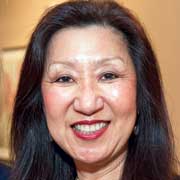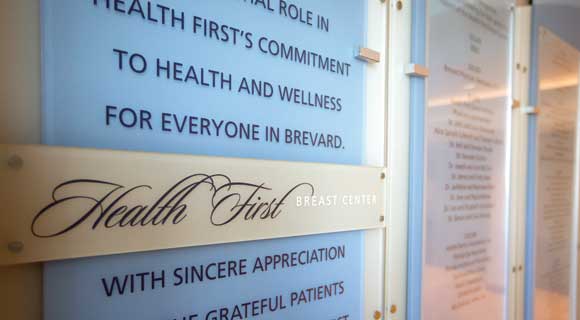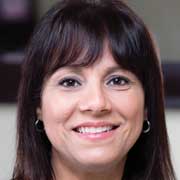Diagnostic Mammography Allows Physicians To View Breast Tissue Layer By Layer
By Maria Sonnenberg // August 20, 2016
SCHEDULE A MAMMOGRAM TODAY

CLICK HERE TO SCHEDULE YOUR MAMMOGRAM TODAY: Diagnostic mammography is a detailed X-ray of the breast using low dose radiation exposure. The Health First Breast Center offers both 2D digital images and 3D mammography, or tomosynthesis, which allows physicians a view of breast tissue layer by layer.
BREVARD COUNTY, FLORIDA – Made reality thanks to community gifts through the Health First Foundation, the Health First Breast Center makes staying healthier a whole lot easier.

The 9,426-square-foot facility, with its cheery, comfortable design, is located at the north end of Health First Medical Group building at 1223 Gateway Drive in Melbourne. Under its roof is a continuum of breast health services for women – and men – of all ages.
Unifying all breast care services is a win-win combination for patients seeking quality care as well as convenience in delivery of service in an atmosphere that minimizes anxiety and stress.
“The Breast Center features state-of-the-art technology and allows better coordination and more efficient care related to breast health,” said Dr. Jeffrey Stalnaker, Health First’s chief physician executive.
“In one location, patients can be screened and/or receive more detailed imaging and breast care. The Health First Breast Center offers radiologists as well as breast and reconstructive surgeons and a nurse navigator to help guide patients through their treatment plan.”
The Breast Center offers the Space Coast’s only multi-disciplinary approach to coordinated breast health, administered by a team of professionals committed to individualized, safe and high-quality care in a compassionate and caring environment.
“A comprehensive approach to cancer treatment entails a multidisciplinary team involving various medical professionals,” said breast surgeon Dr. Sharon Noori.
“For breast cancer, in particular, this approach typically involves radiology, surgery, radiation oncology and medical oncology. Patients seen at the Breast Center will meet with the breast surgeon and reconstructive surgeon, if necessary, usually at the same visit. Furthermore, we hold a Women’s Tumor Board every other Friday, where we discuss management of difficult cases. There is at least one member of each discipline present at the meeting including radiology, pathology, surgery, radiation/medical oncology and nurse navigation.”

Breast Center staff includes one full-time radiologist, four full-time mammographers, two sonographers, one nurse navigator, plus a team of nurses and several other support staff.
“Health First Breast Center provides a supportive environment with a multi-disciplinary team of experts, providing the most up-to-date technology for breast health,” said Marianne Stallings, diagnostic outpatient manager.
Dr. Chanhi Park explains, “The key to early detection is screening mammography. By the time a cancer is palpable, it is usually about 1.0 cm or greater. With screening, by definition, we are trying to find cancers before they are palpable. Screening is for asymptomatic patients. The majority of breast cancers develop in patients without a family history, so it is important for all women to get their annual screening mammogram beginning at age 40.”

Because time can be critical for an optimum outcome, the Breast Center employs a nurse navigator to guide patients with abnormal screening mammograms that may require additional diagnostic work up and biopsy.
“Our patients are contacted by the nurse navigator within 24 to 48 hours after the abnormal screening exam is interpreted to schedule follow-up exams and answer any questions the patient may have,” added Stallings.
“The nurse navigator follows the patient through the entire evaluation process.”
Reduced wait times for results means patients can access treatment quicker. Quicker treatment means better outcomes. The nurse navigator also serves as a patient advocate.
“The nurse navigator guides them through the various aspects of diagnosis and treatment,” said Noori.
“Currently, nurse navigator Robin Ison is focusing her efforts on expediting appropriate work up and biopsy for women who present with abnormal mammograms.”
Breast Center technology includes high resolution diagnostic imaging for digital screening and diagnostic mammography for abnormal screenings. Diagnostic mammography is a detailed X-ray of the breast using low dose radiation exposure. The Breast Center offers both 2D digital images and 3D mammography, or tomosynthesis, which allows physicians a view of breast tissue layer by layer.
Unlike the traditional flat imaging of two-dimensional mammography, the images produced through the use of tomosynthesis find details that otherwise might have been hidden by tissue above or below.
The use of 3D mammography has resulted in 41 percent higher detection rate for invasive cancers and has also minimized false positives by 40 percent, resulting in a 30 percent reduction in call-back rates for abnormal mammograms. 3D mammography is available to all patients, but individuals are encouraged to check with their insurance provider to assure coverage.

The Breast Center also offers ultrasound. Ultrasound uses sound waves to make detailed pictures of areas inside the breast and can be very helpful in further characterizing abnormal findings. A valuable tool in conjunction with mammography, ultrasound helps to distinguish between cysts and solid masses and can help detect benign versus cancerous tumors through a painless procedure that does not expose the patient to radiation.
Magnetic resonance imaging, or MRI, is another diagnostic tool available to Breast Center patients. This technology uses a magnet and radiowaves linked to a computer to make detailed images inside the breast in multiple planes.

Though more invasive than mammography, the technology goes beyond conventional breast imaging to identify breast tumors other exams would fail to detect.
“Approximately one in eight women in the United States will develop breast cancer,” said Dr. J. Patel.
“In 2016 alone, there will be an estimated 246,660 new cases of invasive breast cancer. Our goal is to provide comprehensive services for complete breast health. We provide all kinds of diagnostic tests and surgical treatments, from digital screening mammograms to breast reconstruction.”
BREAST RECONSTRUCTION
Breast reconstruction is an important component of breast cancer treatment.
“Our goal is to provide the safest, evidence-based and most efficient care from the time of diagnosis to surgical treatment,” said Dr. George Collis.

“There are several variables that play a part in a patient’s breast reconstruction and affect the timing and type of reconstruction offered as not the same reconstructive option is the best choice for every patient. Breast reconstruction options and techniques vary and are tailored to each individual patient.
“We provide several types of breast reconstruction, including implant-based, autologous (using one’s own tissue), or a combination of the two following mastectomy and oncoplastic reduction techniques in breast conservation therapy. In addition, we are the only practice to offer DIEP microvascular free flap breast reconstruction in Brevard County. In this procedure, the skin and fat from the lower portion of the abdomen is transplanted to the breast by reconnecting the blood vessels to this tissue in the chest, sparing the abdominal muscles.”
COMPREHENSIVE APPROACH
Research has shown that mammography together with breast MRI can increase detection of breast cancer in women at higher risk of this type of cancer. The National Comprehensive Cancer Network recommends yearly screening with mammography and breast MRI for higher risk populations, such as women with a high family history of breast cancer.
The Center also administers fine-needle aspiration, core biopsy and open biopsies to remove tissue or fluid from the breast for further analysis under a microscope.
To add an additional level of clinical guidance to the program, the Health First Breast center hosts the Breast Program Clinical Committee, which addresses all aspects of the breast program.
“Ultimately, the goal of the breast program is to deliver exceptional and timely care to patients for every aspect of their breast health,” said Noori.

Brevard resident Maribel Soper knows first-hand how important a multidisciplinary approach can be in battling cancer. Soper, diagnosed with cancer at age 29, underwent a mastectomy and was cancer-free for 16 years until 2012, when she was given the devastating news of inoperable Stage IV metastatic breast cancer.
Through treatment by the Health First breast cancer team, Soper’s tumor was reduced to such a degree that by 2013 she was pronounced in remission.
“Health First makes it possible for me and other women and men facing breast cancer in our community to get all the care and treatment they need locally,” said Soper.
“Breast cancer is both a physical and emotional journey. Having a dedicated breast health program with the resources and medical professionals to provide a comprehensive approach and who know and understand what patients need is invaluable.”
For more information about the Health First Breast Center, call 321-728-6002. Take a virtual tour or schedule your screening mammogram online at HFbreasthealth.org













